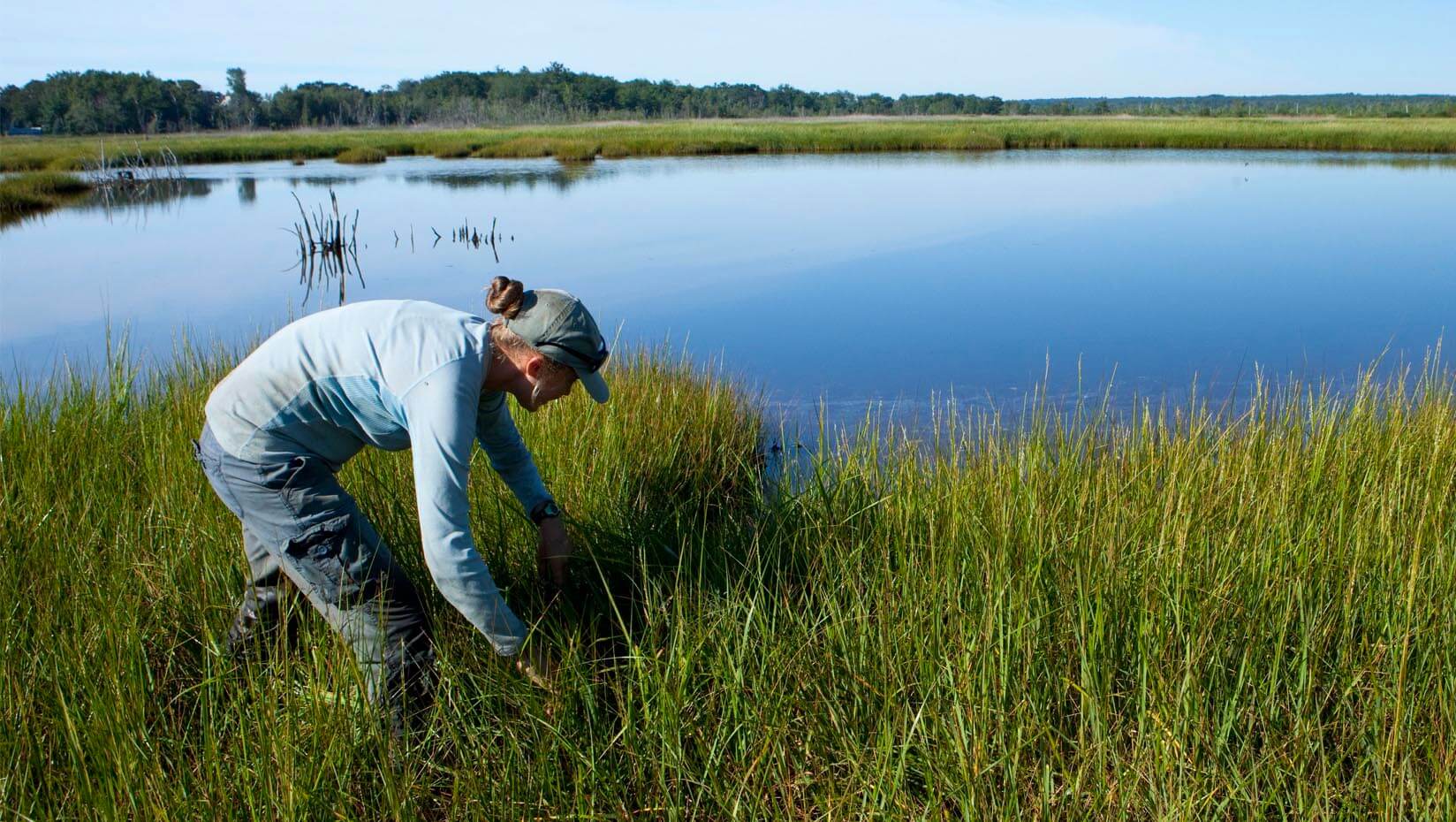
Mercury exposure in tidal marshes affecting breeding success of two sparrow species
Mercury exposure is related to a 10% decrease in nest survival in two tidal marsh songbird species surveyed in four states, from Maine to New Jersey, according to a new University of Maine-led study. These species have been experiencing sharp declines in this region due to sea level rise-related habitat loss and, therefore, mercury may exacerbate known climate change-driven population declines.
Saltmarsh sparrows (Ammospiza caudacutua), which are native to Maine, are declining 9% annually across the northeastern U.S. and Acadian Nelson’s sparrows (A. nelsoni subvirgatus) are declining 4.2% annually from Maine to Massachusetts, according to a UMaine-led study in 2017.
Among the findings of the new study, published in the journal Ecotoxicology: on average, mercury concentrations in the blood of saltmarsh sparrows were 24% higher than those in Acadian Nelson’s sparrows. The saltmarsh sparrow will be considered for Endangered Species protection in 2024 and is predicted to be extinct by 2060, according to a study led by Christopher Field at the University of Connecticut.
Tidal marshes are considered high-risk environments for mercury exposure because they are important habitats for birds, and the biogeochemistry of sediments facilitates the transformation of mercury (Hg) into biologically available methylmercury. Mercury concentrations in blood reflect recent dietary mercury uptake. High Hg toxicity has the potential to impair reproduction.
To characterize spatial and temporal variation of mercury exposure in the two species, the researchers sampled total mercury (THg) in blood collected from 127 female birds captured, banded and released along nearly 348 miles of coastline at nine study plots in four states — Maine, New Hampshire, Connecticut and New Jersey. The study region is nearly 60% of the global breeding range of the saltmarsh sparrow. The Acadian Nelson’s sparrow, with a range from the Canadian provinces to northern Massachusetts, was studied in the four Maine and one New Hampshire field sites.
Compared to risk thresholds for wild birds, 77% of the blood samples from the two sparrow species exceeded the lowest-observed adverse effect level concentration and 4.8% exceeded the moderate risk threshold. One bird exceeded the high risk threshold, according to the study team, led by Kate Ruskin, a UMaine lecturer in ecology and environmental sciences.
The study plots with highest and lowest blood THg concentrations were from opposite ends of the study area — New Jersey and Maine, respectively. The high spatial variability in mercury exposure ranged from more than 45-fold across all individuals and eight-fold in mean blood THg among all study plots, including four-fold between study plots within 2.5 miles. Intraindividual changes in blood Hg exposure varied as much as two-fold within and among years.
During the breeding season, mid-May–August, the researchers resampled individual birds within and over three years to quantify the temporal variation in total mercury levels in blood and test whether there is evidence for systematic increasing bioaccumulation of mercury. The research team coupled breeding female blood mercury concentrations with measurements of nest survival to assess if effects of mercury on sparrow reproduction could be detected after controlling for other environmental factors, including water level during high tides.
Previous research determined that high tides are the largest reported influence on nest survival in saltmarsh sparrows and tidal marsh-nesting Acadian Nelson’s sparrows. The new study found daily nest survival probability was more than twice as sensitive to water level than THg at the mean observed values and over 17 times more sensitive at the highest values.
The study also found a negative relationship between mercury exposure and breeding success related to flooding, one of the leading causes of nest destruction due to sea level rise. Study plots where mean mercury was highest had relatively high nest survival — an apparent paradox because some of the study plots had some of the lowest nest flooding levels. Though this negative relationship between nest survival and mercury is weaker than sea level rise, which is related to large-scale population declines in these species, this pattern demonstrates that reproductive success can be negatively impacted by environmental levels of mercury found in the Northeast.
“Our finding that individual Hg exposure was negatively associated with nest survival via flooding joins a growing body of work that demonstrates that environmentally relevant Hg exposure can have sublethal effects on fecundity in wild birds, and that sublethal exposure to Hg can affect reproduction in ways that are not straightforward, such as through behavior or interacting with other environmental stressors,” wrote the study team, which included researchers from UMaine, U.S. Geological Survey, Vermont Department of Environmental Conservation, University of Connecticut, U.S. Environmental Protection Agency, University of Rhode Island, U.S. Fish and Wildlife Service, University of New Hampshire, University of Delaware and the Cornell Lab of Ornithology.
Out of 113 nests monitored — 90 saltmarsh sparrow and 23 Acadian Nelson’s sparrow — 63 nesting attempts were successful, producing at least one fledgling; 27 failed due to flooding, 14 failed due to predation, and nine failed due to unknown causes.
“We’re grateful we were able to characterize the threat from mercury to these species, particularly the saltmarsh sparrow that faces extinction this century,” Ruskin says. “The negative relationship we found with reproductive success and mercury importantly shows that contaminants can negatively affect wildlife at current environmental levels, but for these species, sea level rise is a much greater threat. We can then more efficiently conserve these species by protecting critical habitat from sea level rise.”
Contact: Margaret Nagle, nagle@maine.edu
